WATERCOLOUR
> Guushendrickx
> ISA DP Web Resources
> How to develop UNDERSTANDING OF ARTWORKS
> Develop your SKILLS with ART FORMS, TECHNIQUES and MATERIALS
> 2D ARTFORM
> PAINTING MEDIA/TECHNIQUES
Five things to know about J.M.W. Turner's watercolours. Usually, for the month of January we welcome you into the Gallery to see our annual exhibition of watercolours by J.M.W.

Turner. This is, for many people, something of a January pilgrimage. With the Gallery temporarily closed, we'll continue to do what we have endeavoured to do over the last few months, and bring your art to you online, wherever you are in the world. Read on to discover five interesting things about the Gallery's collection of work by J.M.W. Turner. 1. Joseph Mallord William Turner (1775–1851) was an English artist who is celebrated for his innovative and experimental approach to landscape painting. Writing in 1890, Henry Doyle, Director of the National Gallery of Ireland from 1869 to 1892, described Turner as "... the greatest artistic genius of the British School and the most poetic and imaginative landscape painter the world has seen.
" 2.
Watercolor professional painting - wet on wet technique. 16 Watercolor Techniques You Have to Try. Hold it right there: Before you start adding fancy details and textures to your work, you need to know a few of the most basic watercolor painting techniques to try.
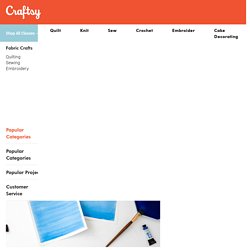
Use these to get started, then build on them however you like. 1. Watercolor Washes There’s more than one way to approach laying a watercolor wash — you can either do it on a wet surface or a dry one. One tip for any watercolor wash: If you notice a mistake in a previous stroke, don’t try to fix it. Dry Wash. 11 Easy Watercolor Techniques that Every Painter Needs to Know. Watercolor painting has long been a favorite medium of expression for enthusiasts and professional artists alike.
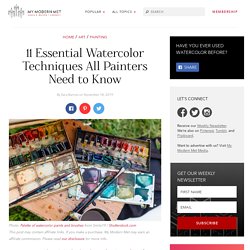
Although you only need a brush and pigments to get started, watercolor is a material with many creative possibilities. By incorporating household supplies into your painting, you can create work that has interesting textures as well as fluid, carefree colors that showcase the best attributes of the medium. Common Tools Needed for Popular Watercolor Techniques. Brushstrokes & Their Effects. Watercolour Fundamentals - Guidance and Demonstration with Andrew Pitt. Watercolor. Clockwise from upper left: brushes, watercolor cakes, porcelain palette, components of watercolor (powdered pigment, gum arabic and water), tubes of watercolor, sponge, knife Prized for the luminosity of its transparent colors, watercolor is a water-based medium that is applied by brush, typically to white paper.

Packaged in cakes of color known as "pans," or in tubes of thickened paint, it is composed of finely-ground pigment combined with water and gum arabic, a binder that disperses the pigment particles to create a uniform solution and adheres it to the support. Modern watercolors form washes with only a touch of water, allowing greater ease of use. The watercolor palette comprises a vast range of pigments. These include colors made from natural minerals, resins, or vegetables; for example, the "earths" (such as ocher and burnt umber), azurite, terre verte, madder root, and gamboge.
Watercolor & White: Why They Belong Together – Greenleaf & Blueberry. Rules are both a blessing and a curse.
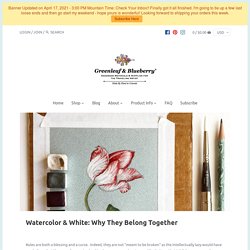
Indeed, they are not "meant to be broken" as the intellectually lazy would have you believe, but they can also create shockingly unnecessary barriers and limitations that inhibit progress and creativity when they are accepted and followed without question, deeper understanding, or critical thought. In the Arts, it is a healthy approach to see rules more as guidelines - learn them, understand them, and then make an educated decision about what you are going to do with them, now that knowledge of them is a part of your repertoire. In essence, you need to own them. Painting after detail of an Alexander Marshall plate of Tulipa gesneriana There have been so many innovations in the history of Art in regards to materials and techniques.
So much has been discovered. What I'm bringing up today is fairly benign: the use of the color White in watercolor painting. For me, the off-limits parts of my first paint set were the White, Black, and Brown.
Watercolor Brush Basics – Greenleaf & Blueberry. Ever browsed the brush aisle at the art supply store and wondered why the heck there are so many options?
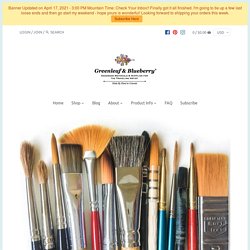
How to Erase Watercolors – Greenleaf & Blueberry. One of the biggest fears I've heard about watercolors over the years is that they cannot be erased, that mistakes are irrevocable.
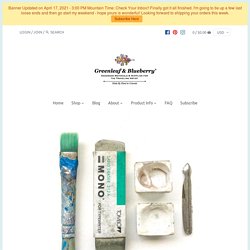
Hearing this never fails to send me to my soap box to passionately defend my favorite medium because: 1) It's simply not true! 2) This is the main reason most people are afraid to even try watercolors.
Characteristics of Watercolor Paint. Watercolor is a medium known for its transparency and fluidity.
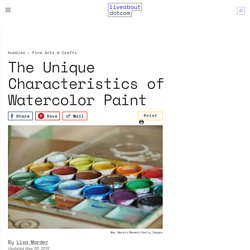
There are three kinds of watercolor paint - tube, pan, and liquid. The following are some of the characteristics common to all watercolors. Quality Like all paints, watercolors come in student grade and professional grade quality. The professional grade has a higher concentration of pigment and better permanence ratings.
Keene Wilson - Page - Focus on Watercolor. Worksheet06 02.
J.M.W Turner
John Singer Sargent. Artist Uses Calligraphy Brushes to Create Breathtaking Watercolor Paintings of Birds. San Francisco-born artist Karl Martens creates beautiful paintings of birds using materials not often paired together – Japanese and Chinese calligraphy brushes with watercolor.

What’s most fascinating is that he paints all of his works by memory, without reference to any guide. What you’ll notice first are the sweeping brushstrokes and then you’ll see all the fine details. While he uses large Japanese and Chinese calligraphy brushes to create the general shape and posture of the birds, the intricate markings of them are done using charcoal pencil and smaller calligraphy brushes.
Martens studied birds for so long that he knows how to paint both the large and subtle differences including the birds’ beaks.Martens is inspired by Shih-t’ao (1642-1707), one of the most famous Chinese painters in the early Qing dynasty. He was considered revolutionary during that time because he didn’t believe in imitating old masters, while he respected them, he forged his own path. Karl Martens website. Watercolor painting. Type of painting method using water-based solutions An artist working on a watercolor using a round brush.
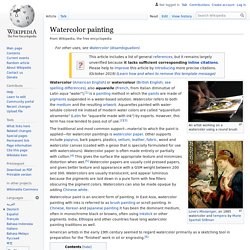
RobertHills 1. 23 Watercolor Artists You Should Know About. Its popularity can perhaps be credited to the fact that it is quite simple to start creating an artwork using this technique, as all one needs is the paints and, typically, paper.
How American artists made watercolour great again. Philadelphia’s presentation of American watercolours is built around the careers of the Boston-born painter and illustrator Winslow Homer (1836–1910), and the younger, European schooled John Singer Sargent (1856–1925). It tells the story of the maturation of American art in the 19th and early 20th centuries, through an examination of the watercolour medium, whose trajectory was not dissimilar to that of American oil painting. After years of sporadic forays into the medium, mostly imitative of foreign artists, Americans advanced watercolour beyond its traditional limits and dispensed with the need for ‘finish’.
Curator Kathleen Foster posits that over this period, watercolour emerged from the margins to become a star-making medium. American watercolourists of the 19th century took their cue from the land of their forebears, inheriting British topographical and picturesque conventions. The Dancing Lesson (Negro Boy Dancing) (1878), Thomas Eakins. The Sisters (1882), Edwin Austin Abbey.










